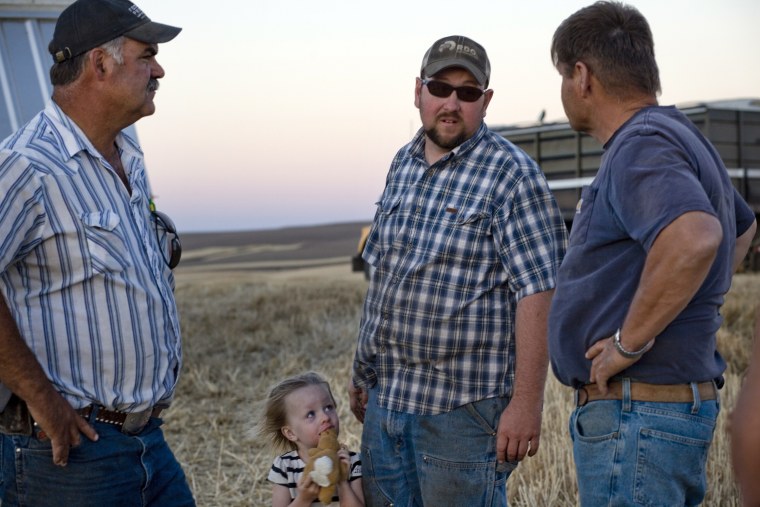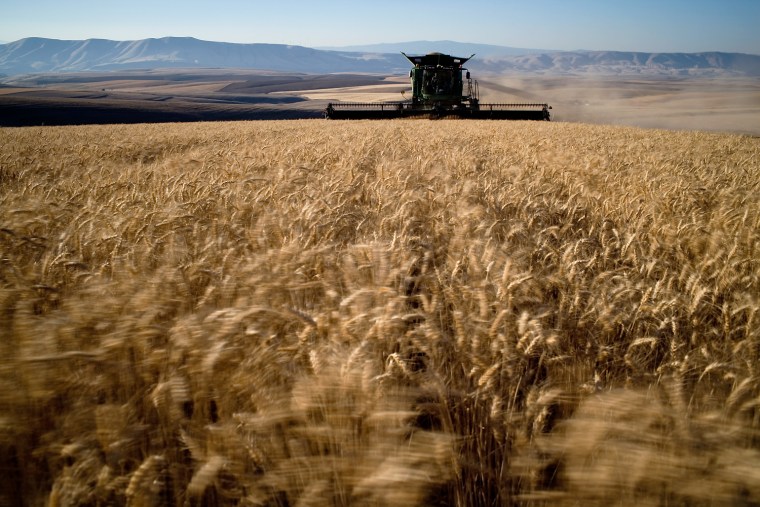Oregon’s wheat farmers are bringing in the sheaves, but they are not doing much rejoicing just yet.
Despite a good crop of soft white wheat, uncertainty hangs heavy over this year’s harvest because of the discovery in late April of a small number of genetically modified wheat plants on a farm in northeastern Oregon. The plants, engineered to withstand the herbicide Roundup, had never been approved for commercial use and weren’t supposed to be growing there.
In addition to stirring up domestic opponents of genetically modified crops, who contend that potential health impacts have not been adequately studied, the find sent shockwaves overseas, prompting Japan, South Korea and Taiwan to suspend purchases of western white wheat grown throughout the Pacific Northwest.
Despite nearly three months of beating the bushels for the contamination source, federal inspectors haven’t found it.
That upsets wheat farmers like Bryan Cranston who depend heavily on overseas sales for their livelihoods.

“We’d just really like to get it resolved … just figure out what happened and make sure it doesn’t happen again,” Cranston said, speaking by cellphone from his combine as he cut wheat near Moro, Ore. “Guys are frustrated.”
While many markets around the world have accepted biotech crops like corn and soybeans for use as animal feed – and to a lesser extent for human consumption – opposition to genetically modified wheat has been particularly strong because wheat is so ubiquitous in human food.
Agribusiness companies that sell genetically modified seed and the U.S. Food and Drug Administration insist the crops are safe, but opponents argue that many of the studies have been done by the companies themselves and haven’t adequately addressed long-term health effects.
The mystery surrounding the winter wheat plants in Oregon has only deepened since an unidentified farmer found them in what was supposed to be a fallow field. Testing by Oregon State University determined the plants were resistant to glyphosate – the active ingredient in Roundup and many other “wide-spectrum” herbicides. The U.S. Department of Agriculture’s Animal and Plant Health Inspection Service, or APHIS, soon traced them to field tests of genetically modified wheat – known as MON71800 -- by the agribusiness and chemical giant Monsanto a decade ago.
But the field tests in 16 states ended in 2004, shortly before Monsanto withdrew its application seeking deregulation of the genetically modified wheat – also known as GMO and GM wheat – and none had been conducted in Oregon since 2001.
Because wheat cannot survive for long in the wild, that left several scenarios:
- Volunteer plants – those that spring up from seed that falls to the ground -- from the test hid in fields of cultivated wheat for more than a decade without detection;
- “Pollen drift” during the field tests “outcrossed” with normal wheat growing nearby, and that seed was used in subsequent plantings or produced volunteer plants;
- Commercial seed the farmer planted in 2011 somehow was contaminated by genetically modified seeds;
- An unknown saboteur planted the rogue wheat, as Monsanto Chief Technical Officer Robb Fraley suggested recently to reporters. “Appearing suddenly after 12 years, out of nowhere in a single field in Oregon is highly suspicious,” he said.
Monsanto says on its website that after the field tests, all remaining genetically modified seed was destroyed, sent to a USDA storage facility and later incinerated, or archived at the company’s headquarters in St. Louis.
“The process was rigorous, well-documented and audited,” said Monsanto spokesman Thomas Helscher. The company also says that no field tests were conducted near the farm where the rogue wheat was found and that the company never field tested winter wheat.
Tests in the farmer’s other fields and adjoining farms, and on tens of thousands of seeds for dozens of varieties of wheat, all came back negative, leading the USDA in June to label this “a single isolated incident.” APHIS, which is leading the investigation, is conducting more-sophisticated DNA testing in an effort to identify the specific variety of the GM wheat, which would allow it to identify specific field tests.
Bill Freese, a science policy analyst with the Center for Food Safety, said the theory that the plants were survivors from the long-ago field tests is far more plausible than sabotage.
“When you grow andharvest, you inevitably leave a certain percentage of seeds in the soil ... and they will sprout the next year. … It’s a real challenge to deal with,” he said, noting that Monsanto was twice cited by APHIS for not monitoring for volunteers in field trials of other GM crops.
The center, a nonprofit public interest and environmental advocacy organization, is a plaintiff in a class-action lawsuit against Monsanto filed on behalf of wheat farmers in Oregon and other states.
Attorney George Kimbrel said the case is similar to a 2006 lawsuit against Germany’s Bayer AG after genetically modified rice that had been field tested years earlier and then discontinued was found to have contaminated shipments of export long-grain rice from the U.S. “Despite extensive investigation, USDA was unable to discern the source of the contamination,” he said.
The suit against Bayer CropScience led to a $750 million settlement to retire claims from about 11,000 U.S. farmers that the export value of their crop was ruined. The company did not acknowledge any wrongdoing.
But plaintiff attorneys in the wheat case, derided as “tractor chasing lawyers” by Monsanto General Counsel David Snively, may have a tougher time demonstrating such damage.
Blake Rowe, chief executive of the Oregon Wheat Commission and Oregon Wheat Growers League, said “prices dropped … by about 50 or 60 cents a bushel” after APHIS said it could not find the source of contamination, but had since rebounded somewhat.
Two of the three countries that suspended purchases of white wheat – South Korea and Taiwan – have since lifted the orders, though they and the European Union have imposed increased testing of imported white wheat to guard against GM contamination. But Japan, the world’s sixth-largest wheat importer and a major purchaser of soft white wheat from the Pacific Northwest, continues to wait.
An agricultural delegation from Japan visited the U.S. last week for meetings with federal officials and wheat growers in Washington, D.C., and in the Pacific Northwest. Takayama Naritoshi, a councillor with the economics section of the Japanese Embassy in Washington, told NBC News of the delegates that “to some extent they are satisfied with the information provided by the U.S. government.”
“But unfortunately … the actual source of the contamination is not yet found. That is a problem for us,” he said.
That’s also a problem for Cranston, the Oregon wheat farmer.
“I want to grow what our consumers want, and that means I want to stay away from GMO,” he said.
More from NBC News Investigations:
